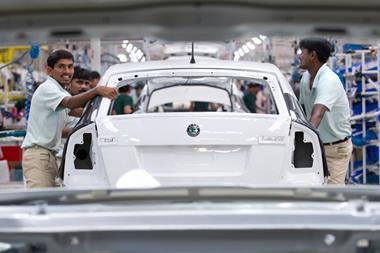
Chinese OEMs are making tremendous progress in design, R&D and manufacturing. These moves are improving their ranges of vehicles and most importantly, their quality and durability. Added to this the lower price of Chinese-brand vehicles is a powerful plus point and the domestic OEMs are marketing their low price advantage heavily in other markets.
It is the privately-owned companies that are pushing exports and transplants hardest, particularly in markets where safety and quality standards are not so high, particularly Africa, South America and Asia.
But it is important for all global OEMs not to underestimate Chinese brands’ potential in China and in all world markets; their hiring of highly-trained and imaginative European, and Chinese, design teams, development engineers and general management is showing that Chinese brands will be present, and ultimately strong, all around the globe.
Trade barriers and taxing out the competition
 Predicting the precise spread of Chinese brands is made more difficult by the constantly changing fiscal obstacles put up by governments in various markets; South America has been particularly difficult for incoming companies, with the Mercosur free trade area changing its complexion several times in the last decade. Brazil’s President Dilma Rousseff, has effectively ‘moved the goalposts’ by reducing the country’s compliance with the Mercosur’s original intentions; to give tax breaks to companies manufacturing anywhere in the region and exporting within the trade area.
Predicting the precise spread of Chinese brands is made more difficult by the constantly changing fiscal obstacles put up by governments in various markets; South America has been particularly difficult for incoming companies, with the Mercosur free trade area changing its complexion several times in the last decade. Brazil’s President Dilma Rousseff, has effectively ‘moved the goalposts’ by reducing the country’s compliance with the Mercosur’s original intentions; to give tax breaks to companies manufacturing anywhere in the region and exporting within the trade area.
Chinese carmakers have built plants in the Mercosur region but now are locating in Brazil to try and capitalise on the region’s growing affluence without paying excessive duties as Alexsandro Godoy de Paula, logistic, imports and purchasing manger for Chery Brasil said while discussing the company’s new production plant at Jacarei at the AMS South America manufacturing conference in Sao Paulo in 2012: “This will be the first 100% Chery production plant outside of China and we are encouraging our suppliers to locate around the plant so that we can all benefit from the favourable tax situation of making cars in Brazil.”
Chery also plans to build a new facility in Brazil to make and supply engines and transmissions for its assembly plant; Head of Chery’s Brazilian operations Luis Curi says the company wants to produce 1.0-litre and 1.5-litre engines locally: “We want to bring all parts of manufacturing to where we make cars and sell them.”
Godoy de Paula and Curi are just two examples of a Chinese carmaker recruiting a local expert for its transplant operations; Tarcisio Telles, the former Director of Production for Latin America at PSA, has moved to Anhui Jianghuai Automobile Co. (JAC) and brought many of his manufacturing department colleagues with him. These moves are said to have been prompted by the news that PSA was going to work more closely with General Motors in several emerging markets, which will likely include South America. Apparently some PSA manufacturing management and engineers did not the relish the thought of working with GM.

JAC – into Africa and South America
In 2012 JAC exported more than 55,000 vehicles in total to its various global markets. It first entered the Africa market when it delivered a batch of light-duty trucks to Algeria in 2001. Nearly 50,000 JAC vehicles have been sold in Africa in the past 11 years. In 2012 about 13,000 units were imported, up 82% from 2011. Accounting for 25% of the company’s exports, the Africa market is a key part of JAC’s push toward globalization. JAC has sold vehicles to more than 30 countries and regions in African markets, including Egypt, Morocco, South Africa and Ghana. Its product portfolio in Africa has also expanded to light, medium and heavy-duty trucks as well as passenger vehicles.
At present, JAC has three assembly plants in Africa, in Ethiopia, Morocco and Egypt, producing A-class cars, SRV, light to heavy-duty trucks as well as other commercial vehicles. It is also planning to build new assembly plants in South Africa and Kenya.
 2012 was a bumper year for the OEM’s South America operations, 30,000 units were exported to the South American market (making up a nearly 60% share of all JAC exported units).
2012 was a bumper year for the OEM’s South America operations, 30,000 units were exported to the South American market (making up a nearly 60% share of all JAC exported units).
JAC’s offering in South America has expanded into A0 class cars from A-class cars (J3 and J3 Turin) with the new J2, and the company sells vehicles in almost all segments; B-class cars (J5 and J6), MPV (M1), vans and commercial vehicles. Brazil is its biggest export market, with nearly 25,000 vehicles sold from March to December 2012.
JAC has also made important steps in building production in the region; in Venezuela, it has opened a KD assembly plant, becoming the first and only KD plant to produce light trucks in the country. In November 2012, it laid the foundations for its Brazil plant in Camacari, in the Bahia region, predicted SOP 2014. With an investment of US$600 million, the plant’s annual production will be 100,000 vehicles. At the same time, it will create more than 3,500 direct jobs and more than 10,000 indirect.
JAC has exported to more than 30 countries in the South American market, and has become the best-selling Chinese brand in Brazil, Bolivia, Columbia and Costa Rica. JAC has risen to be among the top three best-selling Chinese brands in Chile and Peru; while in the commercial vehicles segment, JAC leads Chinese commercial vehicle brands in South America region and is one of the global top two commercial vehicle brands in Peru, Chile, Columbia and Ecuador.
Great Wall – prolific exports and plant building
Great Wall exports to over 100 countries and has sales networks in more than 80 nations. The company is exploring the option of setting up a manufacturing facility in Gujarat, an emerging automotive hub in India. A delegation from GWM travelled to the region recently and explored the possibility of setting up a manufacturing facility in industrial zones like Dahej, Sanand and Halol but also looked at Tamil Nadu and Maharashtra.
With thanks to CEIBS for material from their comprehensive report: The Chinese Automotive Industry In 2012, available from: www.ceibs.edu





































